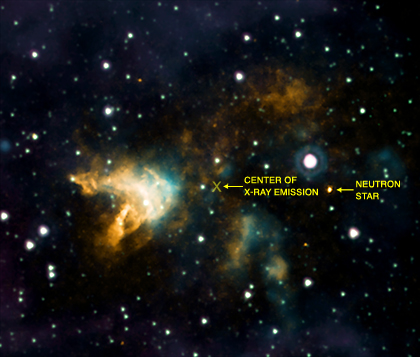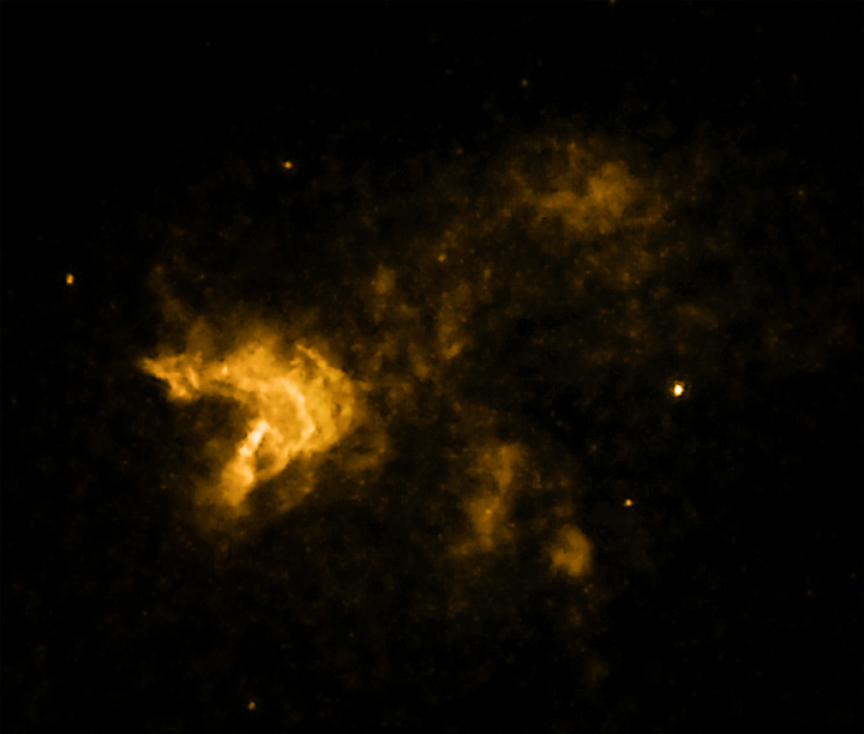

| Visitors Now: | |
| Total Visits: | |
| Total Stories: |

| Story Views | |
| Now: | |
| Last Hour: | |
| Last 24 Hours: | |
| Total: | |
Remnant Of An Supernova Explosion With A Powerful Kick
The latest example of this important investigation is Chandra's new image of the supernova remnant known as G350.1-0.3. This stellar debris field is located some 14,700 light years from the Earth toward the center of the Milky Way .

Credit: Chandra X-ray Observatory
Evidence from Chandra and from ESA's XMM-Newton telescope suggest that a compact object within G350.1-0.3 may be the dense core of the star that exploded. The position of this likely neutron star, seen by mousing over theimage above, is well away from the center of the X-ray emission (mouse-over for this position). If the supernova explosion occurred near the center of the X-ray emission then the neutron star must have received a powerful kick in the supernova explosion.
Credit: NASA/CXC/SAO/I.Lovchinsky et al, IR: NASA/JPL-Caltech
Data from Chandra and other telescopes suggest this supernova remnant, as it appears in the image, is between 600 and 1,200 years old. If the estimated location of the explosion is correct, this means that the neutron star has been moving at a speed of at least 3 million miles per hour since the explosion This is comparable to the exceptionally high speed derived for the neutron star in Puppis A and provides new evidence that extremely powerful "kicks" can be imparted to neutron stars from supernova explosions.

Credit: NASA/CXC/SAO/I.Lovchinsky et al
Another intriguing aspect of G350.1-0.3 is its unusual shape. While many supernova remnants are nearly circular, G350.1-0.3 is strikingly asymmetrical as seen in the Chandra data in this image (gold). Infrared data from NASA's Spitzer Space Telescope (light blue) also trace the morphology found by Chandra. Astronomers think that this bizarre shape is due to the stellar debris field expanding into a nearby cloud of cold molecular gas.
The age of 600-1,200 years puts the explosion that created G350.1-0.3 in the same time frame as other famous supernovas that formed the Crab and SN 1006 supernova remnants. However, it is unlikely that anyone on Earth would have seen the explosion because of the obscuring gas and dust that lies along our line of sight to the remnant.
These results appeared in the April 10, 2011 issue of The Astrophysical Journal. The scientists on this paper were Igor Lovchinsky and Patrick Slane (Harvard-Smithsonian Center for Astrophysics), Bryan Gaensler (University of Sydney, Australia), Jack Hughes (Rutgers University), Stephen Ng (McGill University), Jasmina Lazendic (Monash University Clayton, Australia), Joseph Gelfand (New York University, Abu Dhabi), and Crystal Brogan (National Radio Astronomy Observatory).
Contacts and sources:
Chandra X-ray Observatory
Read more at Nano Patents and Innovations
Source:


